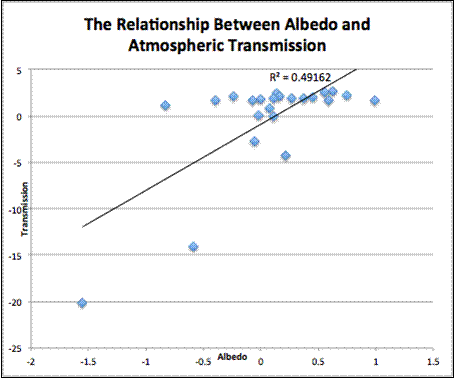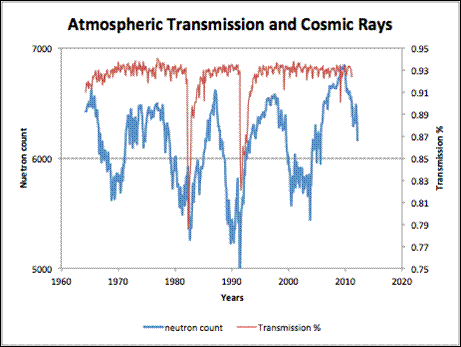On Cosmic Rays and Clouds
By Ed Caryl
There have been several papers and articles recently about Svensmark’s theory that claim cosmic rays produce cloud nuclei, which in turn produce clouds that affect the Earth’s climate. My recent article showed the relationship between atmospheric transmission, the Earth’s albedo, and temperature.
 Photo by Krish Dulal.
Photo by Krish Dulal.
If cosmic rays produce micro-particles that grow into cloud nuclei, and if these particles are large and numerous enough to interfere with sunlight, it should be possible to show a relationship between cosmic rays and atmospheric transmission, and thus clouds.
Relationship between albedo and atmospheric transmission
The transmission is measured in a clear-sky situation. Albedo reflection is mostly from clouds. If aerosols impede transmission and aerosols ultimately produce clouds, then there should be a relationship.
Figure 1: Relationship between albedo and atmospheric transmission.
The problem with Figure 1 is that we only have a few annual data points for albedo. There isn’t a single database for global cloudiness with any temporal extent other than the above data. Two of the points are due to a volcanic eruption. Without those points only a slight relationship remains.
Figure 2: Relationship between albedo and atmospheric transmission after subtracting the two years of Pinatubo volcanic dust.
This result seems to suggest that only large dust and sulfate particles make much difference to clouds and albedo. This may explain the next result.
Figure 3: Monthly data plot of atmospheric transmission and the Oulo, Finland neutron count proxy for cosmic rays. Source of neutron data here.
The problem with this plot is that the volcanic eruptions just happened to occur at negative cycles of the neutron count. We know (or are at least fairly certain) that volcanoes and cosmic rays are not related in any way. For that reason, in the next plot, data from the two years after each volcanic eruption was deleted to avoid a false appearance of correlation.
Figure 4: Monthly data plot of atmospheric transmission versus Oulu neutron count.
Without the volcanic activity in the plot there is no relationship between atmospheric transmission and cosmic rays as measured by the neutron count at Oulu, Finland. The R-squared value is below 0.01, and in the wrong direction. The relationship is completely random.
This result does not necessarily falsify Svensmark’s theory. There may be an explanation as to why cosmic ray flux does not show up in atmospheric transmission. As suggested above, perhaps the particles are too small, or too infrequent compared to other aerosols, but it is another mystery that demands an explanation.








You are confirming what Leif Svalgaard says. On the other hand we have Nir Shaviv and Nigel Calder telling us that there is a relationship but only in certain situations (maybe only local when the atmosphere lacks other sources of aerosols, in pure air above the pacific). But it doesn’t seem to explain the warming and cooling phases in the 20th century.
Again, thanks for the analysis; especially the exclusion of the volcanic events is very informative.
You are confirming what Piers Corbyn says, too:
“The problem is that while his theory correctly identifies charged particles as very important in cloud formation it points to the wrong charged particles.
His theory elevates Cosmic Rays which are a proxy for solar activity into Cosmic Rays as a supposed agent of sun-earth connection. It is like elevating the length of a mercury column in a glass capillary to the CAUSE of temperature when of course the length of the Mercury column is an effect of temperature not a cause of it.Galactic Cosmic Ray (GCR) counts are modulated by the total magnetic flux of the sun in the solar system and are a measure of it but they are not the agents of sun-earth connection. The solar particles themselves and sun-earth magnetic links are that.
The test is simple and the GCR theory fails.
The sun’s total flux activity AND CONSEQUENTLY Cosmic Ray flux follow the 11 year solar cycle like clockwork. GCR variation is an EFFECT of the size of solar-magnetic activity. This is an undisputed fact and there are loads of observational graphs of GCR which show the large 11 year cycle (nb make sure graphs are not smoothed over 22 years in advance! and beware of the concept of solar cycle length because if over 22 years it conceals the crucial 11 year signal). Therefore if GCR are the agent driving temperatures the main world temperature fluctuation MUST BE the 11 year cycle, but it is not. The vastly dominant world temperature cycle is the 22year magnetic Hale cycle which governs the sun-earth connectivity.”
This comment can be found here:
http://climaterealists.com/?id=9491